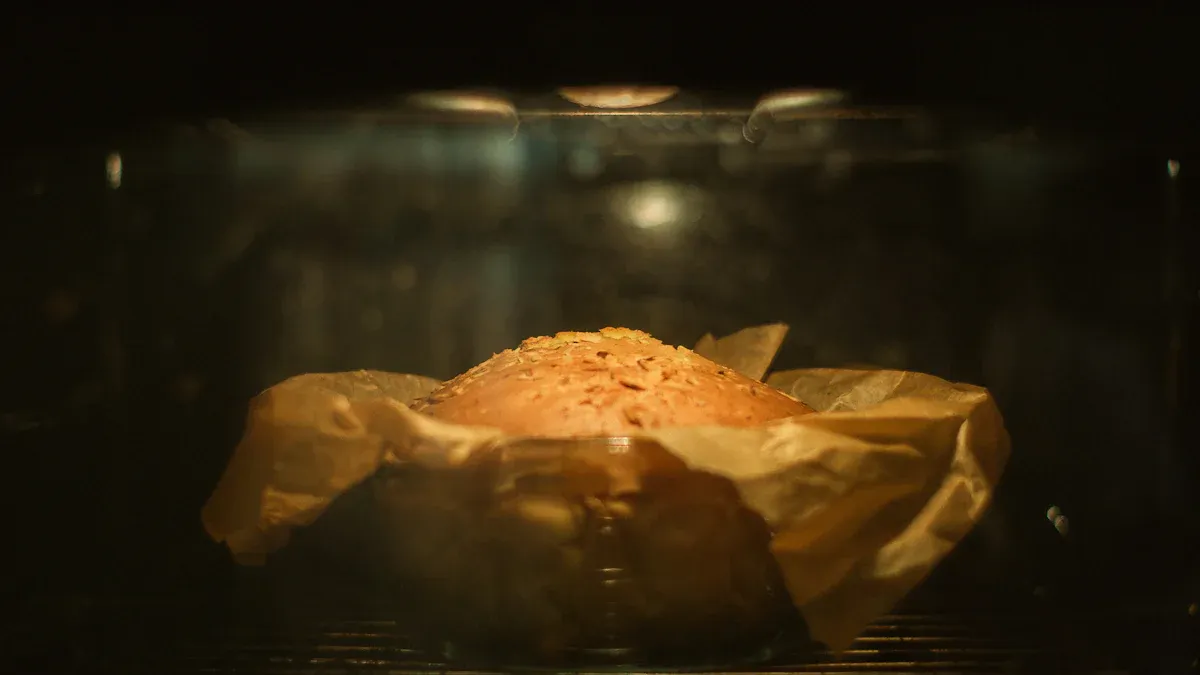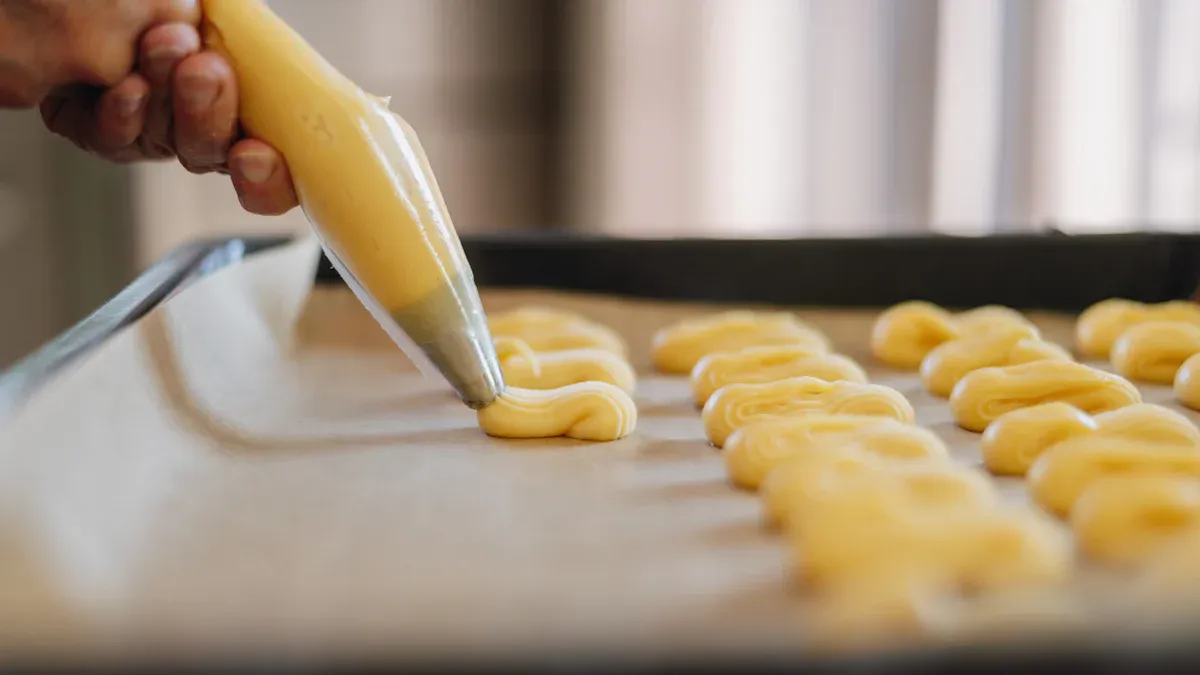You may ask, "Can you put parchment paper in the oven?" Yes, it is safe to use. Always check the temperature limit on the box before baking. Be sure not to let parchment paper touch flames or heating elements. Many people use parchment paper for cookies and cakes, and it is also excellent for roasting vegetables. Parchment paper prevents food from sticking and makes cleanup a breeze.
Key Takeaways
Parchment paper is safe in the oven if you check the temperature limit on the box. Most parchment paper can handle heat up to 450°F.
Always keep parchment paper away from flames or heating parts. This helps stop fires from starting.
Do not use parchment paper under the broiler. The high heat can make it catch fire.
Parchment paper makes baking easier. It stops food from sticking and makes cleanup simple. You can just lift it out and throw it away after you bake.
For best results, cut off extra parchment paper. This helps stop burning and makes sure it fits your pan well.
Can you put parchment paper in the oven

You might wonder, can you put parchment paper in the oven? The answer is yes, but you need to follow some important safety tips. Let’s break down what you need to know before you start baking.
Temperature limits
When you ask, can you put parchment paper in the oven, the first thing to check is the temperature limit. Most parchment paper can handle oven temperatures between 400°F and 450°F. Some brands even say you can use it up to 500°F, but you should always look at the packaging for the exact number. Here’s what you should remember:
Most heat-resistant baking papers are safe up to 450°F (232°C).
Always check the box or packaging for the specific temperature limit.
Some parchment paper can go a bit higher, but don’t guess—read the instructions.
Tip: If you bake at a high temperature, keep an eye on the parchment paper. If it starts to brown or curl, it’s time to take it out.
Here’s a quick table to help you remember the most common packaging instructions:
Aspect | Details |
Temperature Limit | Standard parchment paper can withstand up to 420°F (215°C) for baking and roasting. |
Handling Instructions | Avoid direct contact with heating elements and use flat baking sheets to prevent curling. |
Monitoring | Check for browning or brittleness during cooking and remove promptly to prevent overheating. |
Alternatives for High Heat | For temperatures above 450°F (232°C), consider using ceramic fiber paper or aluminum foil. |
Direct heat risks
You need to be careful about where you place parchment paper in the oven. Can you put parchment paper in the oven if it touches the heating element? No, you should never let it touch the oven’s heating elements or open flames. Here’s why:
Parchment paper can catch fire if it touches a heating element or gets too close to a flame.
It can ignite quickly at temperatures around 420°F–450°F.
If the edges of the parchment paper stick out, they might char or burn.
Safety Note: Always trim any extra parchment paper that hangs over the edge of your pan. This helps keep it away from the oven walls and heating elements.
If you use a convection oven, make sure the parchment paper stays flat. The fan can blow it around, and if it moves onto a heating element, it could catch fire.
Broiler safety
Now, can you put parchment paper in the oven under the broiler? The answer is no. Broilers get much hotter than regular baking temperatures. They can reach over 500°F, which is way above what parchment paper can handle. Here’s what you need to know:
Broilers can go well above 450°F, making parchment paper unsafe.
Parchment paper is only heat-resistant, not fireproof. It can melt or catch fire under a broiler.
Even if you keep the paper away from the flame, the intense heat can still cause problems.
Warning: Never use parchment paper in a broiler or toaster oven. The risk of fire is too high.
If you need to cook something under the broiler, try using a broiler-safe pan or aluminum foil instead. Save parchment paper for baking, roasting, and other oven tasks that stay within safe temperature limits.
So, can parchment paper go in the oven? Yes, as long as you follow these safety tips. Always check the temperature limit, keep it away from direct heat, and never use it under the broiler. When to use parchment paper? It’s perfect for baking cookies, roasting veggies, or lining pans for easy cleanup.
Baking with parchment paper

Lining pans and sheets
Baking with parchment paper makes kitchen work easier. You can put parchment paper on pans and baking sheets. This gives you a smooth, non-stick surface. Batter stays in place and helps cakes rise. Your cookies and cakes bake evenly because heat spreads out well. Cookies baked on parchment paper have golden, crisp bottoms. They do not stick or burn.
Tip: Cut parchment paper to fit your pan. This stops the edges from curling or burning.
Here are some top ways to use parchment paper for lining pans:
Baking cookies, cakes, and brownies
Roasting chicken, bacon, or vegetables
Making pizza or bread
You can use Highend Home baking paper for all these jobs. Our products help you get great results. You can bake for fun or for family events.
Preventing sticking
No one likes scraping cookies off a pan. Parchment paper stops this problem. The non-stick surface works better than greasing pans. It is great for delicate baked goods. You do not need extra oil or butter. This keeps your treats lighter.
Parchment paper is made for high-temperature baking.
Most recipes do not need you to grease the paper, even for fatty foods.
You get easy release for fancy shapes and fragile items.
If you want your baked goods to keep their shape, use parchment paper. Highend Home parchment paper keeps your treats looking and tasting great.
Easy cleanup
Cleaning up after baking with parchment paper is simple. Just lift the paper and throw it away. You do not need to scrub pans or soak trays. This saves time and keeps your kitchen tidy.
Aspect | Parchment Paper | Non-Stick Pans |
Texture and Browning | Makes food crisp and brown evenly | Depends on the pan’s material and coating |
Release Ease | Great for fancy shapes and fragile goods | Good, but depends on the pan’s design |
Flavor Integrity | Keeps natural flavors | Some foods may taste metallic |
Many home bakers say, “Highend Home parchment paper makes baking and cleanup easy. I never worry about stuck-on messes!” Try our baking paper next time and see the difference.
Want to make your kitchen better? Pick Highend Home for the best parchment paper uses. Baking will be easier, cleaner, and tastier.
Can you bake with parchment paper safely
Baking with parchment paper is easy and safe if you follow a few simple steps. You might wonder, can you bake with parchment paper for all your favorite recipes? Yes, you can! Let’s walk through the best ways to use it and keep your kitchen safe.
Step-by-step use
Here’s how to line your pan with parchment paper for the best results:
Cut the parchment paper about 4 inches longer than your pan.
Fold the paper so it fits snugly inside the pan.
Lift the top folds on both sides.
Fold each corner into a triangle and press it into the pan’s edge.
Repeat for all corners.
Make sure the paper covers the whole inside of the pan.
Tip: Trim any extra paper so it does not hang over the pan’s edge. This helps prevent burning.
When to use parchment paper? Use it for cookies, cakes, roasting, and even for sticky foods. It works great for almost any baking project.
Preventing burning
You want to keep your parchment paper from burning. Here are some tips to help you:
Keep your oven below 425°F. High heat can cause burning.
Always trim the edges so they do not touch the oven walls.
Use high-quality parchment paper for better heat resistance.
Do not overlap sheets. This helps your food bake evenly.
Watch your baking time. Take out the paper if it starts to brown too much.
If you bake at high temperatures often, try a silicone baking mat for extra safety.
What to do if it browns
Sometimes, parchment paper turns brown during baking. Is this safe? Most of the time, yes. Parchment paper is coated with silicone, which is non-toxic and heat resistant. If you see browning, check if the paper is brittle or cracked. If it is, replace it before your next batch.
Some brands use PFAS for nonstick properties. These can pose health risks. Look for parchment paper labeled as PFAS-free and untreated to keep your food safe.
Note: You can reuse parchment paper for low-mess foods like cookies. If it gets too dark or breaks, use a new sheet.
If you ever wonder how to keep parchment paper from sticking, always place the shiny side up. This gives you the best nonstick surface for your treats.
You can put parchment paper in the oven if you follow some easy rules. Here are the most important safety tips:
Check the box for the highest oven temperature allowed.
Use an oven thermometer to make sure it is not too hot.
Look for any burning or smoke while baking.
Choose parchment paper that fits your recipe.
Keep parchment paper away from flames or heating parts.
Here is a table that shows how parchment paper and silicone mats handle heat:
Baking Liner | Maximum Temperature |
Parchment Paper | 420°F (215°C) |
Silicone Mats | 480°F (250°C) |
Unbleached parchment paper gives a natural, non-stick surface and does not add chemicals to your food.
You can bake without worry. Parchment paper helps make baking simple, safe, and neat every time.
FAQ
Can you reuse parchment paper?
Yes, you can reuse parchment paper if it looks clean and not too brown. If it gets greasy or starts to crumble, grab a new sheet. You get the best results with fresh paper for each batch.
Is parchment paper safe for all ovens?
You can use parchment paper in most ovens, including gas and electric. Just keep it away from direct flames and heating elements. Always check the temperature limit on the box before you start baking.
What are substitutes for parchment paper?
If you run out, try silicone baking mats or lightly greased aluminum foil. Wax paper works for cold recipes, but not for baking. Each substitute has its own pros and cons, so pick what fits your recipe best.
Can you use parchment paper for roasting meat?
Yes, you can use parchment paper for roasting chicken, fish, or vegetables. It helps prevent sticking and makes cleanup easy. Just make sure the oven stays below the paper’s temperature limit.
Why does parchment paper turn brown?
Parchment paper turns brown when it gets close to its heat limit. This is normal and usually safe. If it gets too dark or starts to break, replace it with a new sheet for your next batch.






















